Magnum S-3 350 10 Meter AM Export Radio Review

Magnum is back with another new radio and this time around the theme is “you can’t have too much of a good thing”. They’ve taken the Magnum S3 which has been a popular export radio for a number of years and beefed it up with a brand new amplifier section added on to the bottom of the radio.
THE RADIO
This new radio is a Magnum S-3 with a higher output power so while the “name” is new, the radio, performance, and features remain the same. Now with a radio like the S-3 that’s a good thing because the original radio was a winner and has proven itself as a very popular radio with drivers all across the country.
It has some of the cleanest, loudest AM audio you’ll find these days and adding more kick can only increase its appeal.
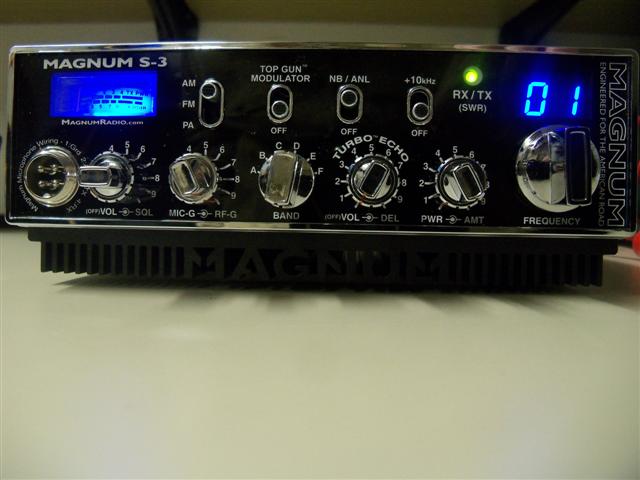
The Magnum S-3 350 is a 10 meter export radio with AM and FM modes along with the following features:
- Volume (on/off)
- Squelch
- Microphone Gain
- RF Gain
- Band Selector (A-F)
- Turbo Echo (Volume level and delay)
- Variable Power
- Variable Talkback
- AM / FM / PA modes
- Top Gun Modulator
- NB/ANL
- 10kHz
- RX/TX Indicator LED (also SWR LED)
- Mechanical Meter and LED Channel Indicator
Most of these features are fairly familiar to CBer’s out there but let me touch upon a couple of the features that really make the Magnum “S” series special.
TURBO ECHO – One of the best echo systems you’ll hear on the market. It can make a variety of effects possible and it allows you to add a distinct sound to your audio.
VARIABLE TALKBACK – Often with CB radios or export models you end up with talkback that is too loud, too soft, or has issues with feedback. The variable talkback on the Magnum radios has always impressed me and it really is completely variable so you can have it loud or soft. These systems match up well with the echo boards to allow you to customize your sound.
VARIABLE POWER – On a big radio like this I think this feature is probably the most important. You may not want to be pushing 300 watts of power if you’re only two miles away from your buddy on his CB so being able to adjust your power level wherever you like is important.
TOP GUN MODULATOR – There continues to be debate on how the Top Gun Modulators work and whether or not radios sound better with or without the module but the facts still remain that this module does allow the Magnum radios to key low and swing high with some of the loudest audio on the market. On radios where people try to max out the AMC maybe the modulators can cause distortion but on the test model we ran with only a mild tune the audio was clear and loud. We could swing from a 1 watt deadkey up into the 100’s of watts without any issues whatsoever.
THE NEW AMPLIFIER SECTION
If you read my review of the Magnum 257HP or Omegaforce S-45HP then you’re probably familiar with the RFX-75 system that was mounted on the back of those radios. The RFX-75 uses the ERF-7530 transistor to produce 60-70 watts of output on those models.
What Magnum did for this new 350 watt model was to take the case/heatsink from the SX-175 system and add a new amplifier section that incorporates four of the ERF-7530 transistors in a push-pull setup. This amplifier section is powerful and it produces very high wattage which puts this radio in the high-power radio class with models like the RCI-2970N2 and Ranger RCI63FFC4.

The amplifier section has large power wires feeding it from the inside of the radio and has multiple wires connecting to the circuit board. If you do ever open the radio up to make adjustment be very careful when removing the bottom cover.

The radio does have 4 x ERF2030 transistors that mounted inside the radio and are the drivers for the amplifier section of the S3 350.

BIG HEAVY HEATSINK
When you have a high powered radio putting out lots of watts you’re going to have transistors creating heat and that heat needs to be dissipated either through the use of fans or by using a heatsink. For this model Magnum has chosen to use a heatsink and they one they use has to be the most heavy duty heatsink you’ll find on an export radio. It is VERY substantial and I’d venture to say that the weight of the heatsink makes up 75% of the total weight of the radio.
In testing we found it did a capable job of removing heat from the radio and while during heavy use it could get warm, it didn’t get as warm as smaller heatsinks on other high power radios we’ve tested in the past. In fact I found it actually ran cooler than the heatsink on the RFX-75 systems that we’ve tested.

One other thing about the heatsink is that it is pretty trick….Magnum had their name cut into the bottom which definitely adds to the visual appeal of the radio.

BIG POWER WIRES
So I think by now you’re probably starting to get the theme of this radio (Big Power, Big Heatsink, Big Power Wires, etc). The radio will pull some serious amperage to provide those transistors with enough juice so they can convert it into big wattage. You’ll find the amperage pull on high around 40 amps. When you have that kind of amperage pull you need to have large power wires to allow the free flow of power and to handle the current safely. You’ll need to make sure during your install to at least match the power wire size but I’d definitely recommend 8 gauge or larger wire for install. The fuse that is included with the power wires is a 50 amp fuse.
One of the nice things about this model and the power wires is that it comes with one of the best quick disconnect systems you can buy. The Anderson powerpole quick disconnects are great and I’ve used them on many of my amp setups in the past. Nice to see a manufacturer using a proven product on their radio rather than trying to add on a cheaper version or make their own.
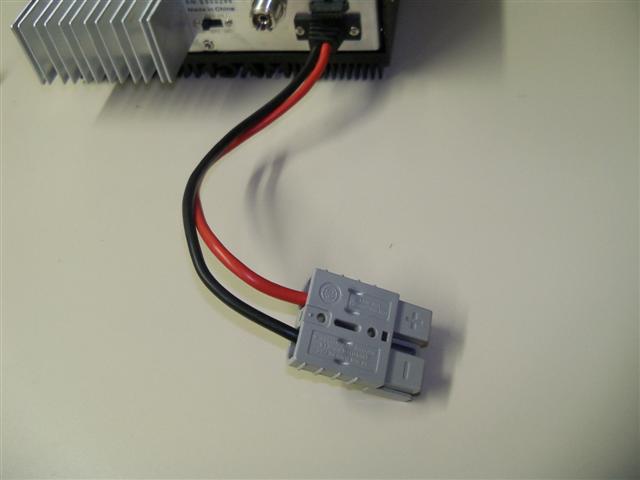
REAR END / MICROPHONE / SPEAKER
The Magnum S-3 350 has a heatsink on the back of the radio – one might ask why? You’ll remember those ERF-2030 transistors we showed earlier mounted along the back case of the radio….yes the radio needs to dissipate the heat from those as well.
You’ll find your PA and EXT speaker jacks at the back of the radio as well as a connector for a frequency counter. If you do decide to run this radio on the upper or lower freeband frequencies (there is some DX on AM on the lower frequencies) this jack allows you to add an external 6 digit frequency counter. Now truthfully for the AM trucker market I don’t see much need for this (and I’d rather most CB’ers stay on the regular 40 channels or nearby freeband frequencies to avoid upsetting the Hams) but in Europe and other markets this feature might be pretty popular.
The power wires run directly into the radio so all you’ll see there is a spacer piece with screws holding it onto the back of the radio. This is actually something to keep in mind – if you ever do see this piece start to come loose over the years (I doubt it will happen) make sure to re-secure it as your power wires run directly into the radio and you wouldn’t want anything to be pulling on them where they connect to the circuit board.
There also is a switch in the back middle of the radio that is there to allow you to turn the SWR warning light on or off, or to turn on/off the “Nitro Knobs” if those are installed on the version you own.
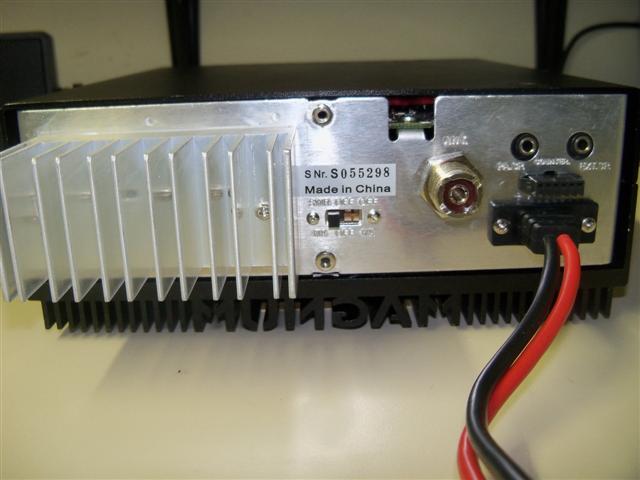
The microphone on the Magnum S3 350 was not the usual one included with the older S3 models and it has a nice look and feel to it but it isn’t anything special. While stock microphones for most radios are usually tossed aside immediately with Magnum radios I find in many cases a stock microphone (either the included one or a SRA-158) matches up very well with the loud audio of these radio. Power microphones on Magnum radios are really unnecessary and the way many people run them actually causes distortion and ruins the great sound these radios produce. So I’d definitely suggest giving the stock microphone a try.
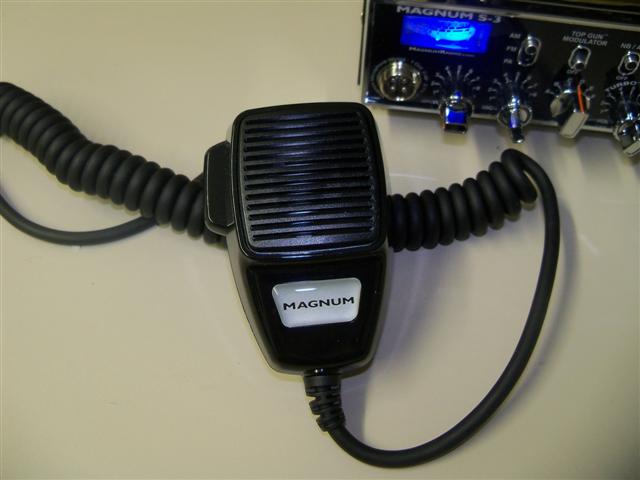
The Magnum S3 350 comes with an external speaker – the Magnum ES-12 Heavy Duty External Speaker. Now the first question in many people’s minds would be – why do I need an external speaker?
Because the amplifier section of this radio is mounted on the bottom cover/heatsink (where your internal speaker would normally be on a regular CB) there is no room for an internal speaker. On radios like the RCI-2970N2 they solve this problem by using a smaller speaker but Magnum has opted for the external speaker option. Now this may seem like a little bit of a hassle but in real world use an external speaker usually sounds better than the internal speakers installed in most radios.
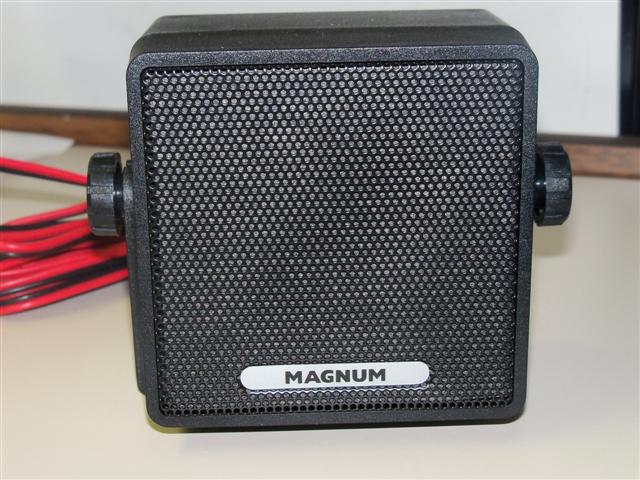
We found this external speaker to be well built and the sound quality was as good as any other external CB speaker currently on the market.
CONVERSION
This radio is an export radio and because of that it’s not set up to be used on CB channels from the factory. You have to do a modification to get it to work on the CB frequencies.
The modification is fairly simple but it does involve opening the radio, removing a circuit board (unscrewing and pulling aside) and removing a jumper.
On the inside of the radio right near the channel selector you’ll see a circuit board with a screw mounting it to the outside case of the radio.
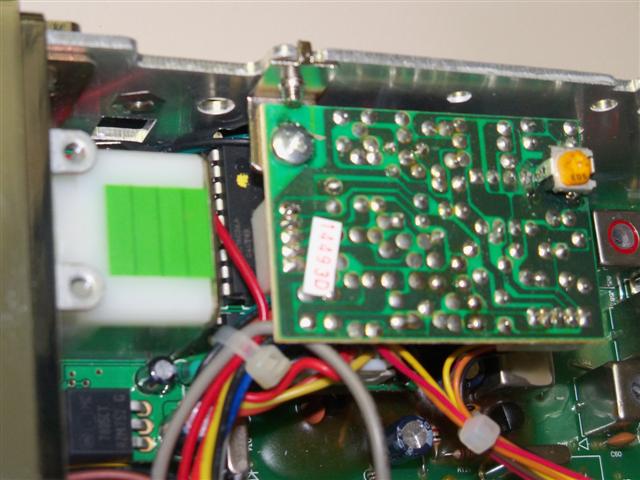
Remove the screw and pull the circuit board safely to the side. This will expose two small black jumpers that sit on some pins on the circuit board below (in the picture below the closest jumper has already been removed). To convert the radio for CB use just pull the inside jumper straight up and off the two pins. It should look like the picture below.

You might want to hang on to the jumper in case you ever need to restore the radio to original or need a replacement jumper. Now you can convert the radio to cover some different frequencies but you can read more about the whole process here

PERFORMANCE
I think we’ll gloss over the basics and get to the output since that’s what everyone will be interested in. The radio performed exactly like a normal Magnum S-3 on receive, transmit audio, echo, talkback, etc. The Magnum S-3 has always been very capable in all of these areas and this radio performs to specification.
The additional power didn’t effect any of the other features and the talkback etc didn’t have any issues with squeal, etc that can occur when boosting wattage in a radio or with an amplifier.
The output on the radio was impressive and while it was not 350 or 400 watts as I’ve seen advertised in some places, it did hit the 300 watt mark with impressive swing. You can lower the deadkey down to as low as a couple of watts and still swing into the high 200’s.
I was impressed by the power output and it easily allowed me to make DX contacts during testing. Audio was loud and I got many good reports from other stations. More impressive to me was how the radio worked inside the vehicle. I didn’t have any problems with feedback when running the talkback, the power delivery on my meter was smooth from deadkey to peak, and overall it was very similar to running the original S3. This is an important point for me because many times when you run radios with internal amplifiers you are very aware you’re running a larger radio because of heat issues, feedback, inability to lower your output, etc. I found the new S3 350 gave me the power without the awareness of running a large radio….except for the heavy actual weight of the radio which actually managed to work the screws loose from the mounting bracket I had hastily installed in the vehicle (make sure to attach the bracket securely).
Now I did decide to do something I don’t normally do with high power radios and that was a carrier test. With many high power radios over the years I’ve seen a lot of heat issues and initially the lack of a fan on this model worried me a bit. So I proceeded to key at the maximum carrier of 80 watts for 20 minutes with this radio (not something most people would do or recommend with a radio with an internal amplifier). After 20 minutes the heat sink was quite warm but nothing terrible and in fact I’ve had basic dual final radios that had hotter heat sinks after the same type of test.
I don’t know if this speaks scientifically to any type of durability of the finals or the ability of the heat sink to dissipate heat, but after my testing I’ll say the heatsink seems adequate even without the fans. Now I will point out that this was with the radio being virtually stock. I’m sure some golden screwdriver techs out there will try to see if they can get more watts out of these radios and then will hand the radio to some end user who will throw a musical carrier for 30 minutes and blow their radio and complain online about it (there’s always someone).
COMPLAINTS
I really didn’t find many faults with the radio although there are a couple of things I’ll mention. We all know by now that Magnum knobs have a bit different feel from other radios which I’ve mentioned in other reviews. I prefer the feel of the old Cobra style knobs but even so they work perfectly and durability isn’t a issue so it’s just a preference thing. The other thing I’ll mention is the meter. I really would like to see the large round style meters on these radio as these days the small rectangle meter seems dated.
SUMMARY
When I first posted the video of this radio on one of the popular radio forums the first question that came up was why would someone want this much power in an all-in-one unit, why not just run a radio + amplifier? The next person to reply pointed out that many truckers don’t own their rigs and have to move radios in and out of their vehicles (often they have their setups in special boxes that can be placed in the cab) and these radios offer the ability for them to have enough power to talk further distances without the hassle of an external amplifier.
The two people who posted up made great points. This radio isn’t for your average CB’er. The high power of this radio will appeal to some specific groups of people such as truckers who want that all in one unit, serious AM talkers who want to talk DX but don’t have the room in their vehicle for an amplifier, or maybe for those who don’t have the experience in matching radios to amps and making the proper hookups.
Maybe that sounds a little silly to the more experienced radio operators but as we know sometimes external amplifiers can be tricky, and jumper length, grounding, and dead key input can create headaches during setup. The radio with the internal amplifier does bypass a lot of that hassle so that may make it a viable option for operators
In summary it’s definitely fair to say again that this radio isn’t for everyone. It puts out more power than most CB’ers need to talk local and it’s fairly pricey ($400+) although still cheaper than some of the other high power models of similar output. For those that do purchase the model they will be rewarded with the famous Magnum audio and 300 watts of output to guarantee they get heard. And believe me, after running this radio for two months I can verify it will get you heard both locally and in DX land.
